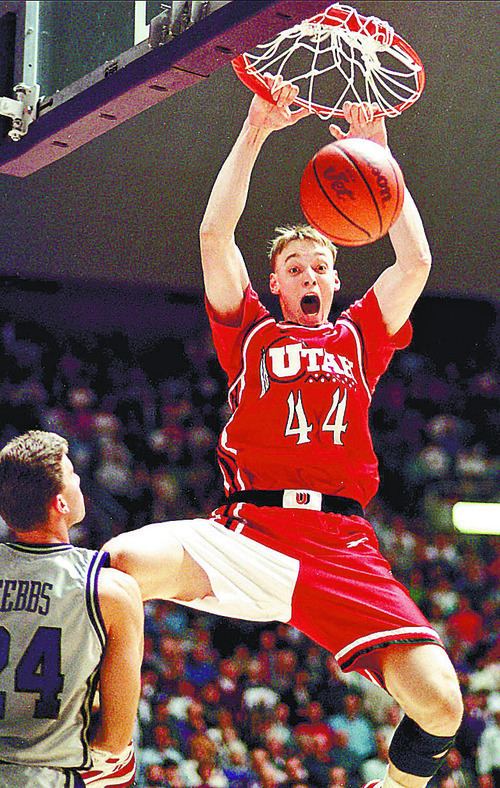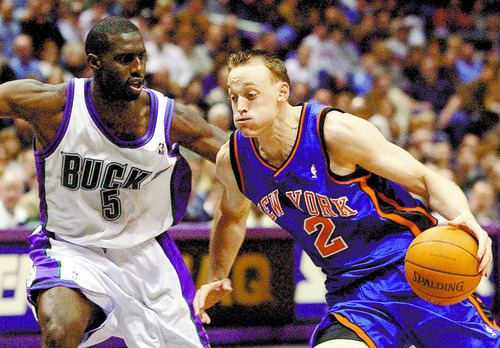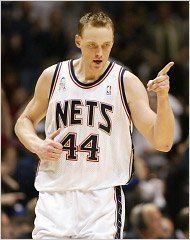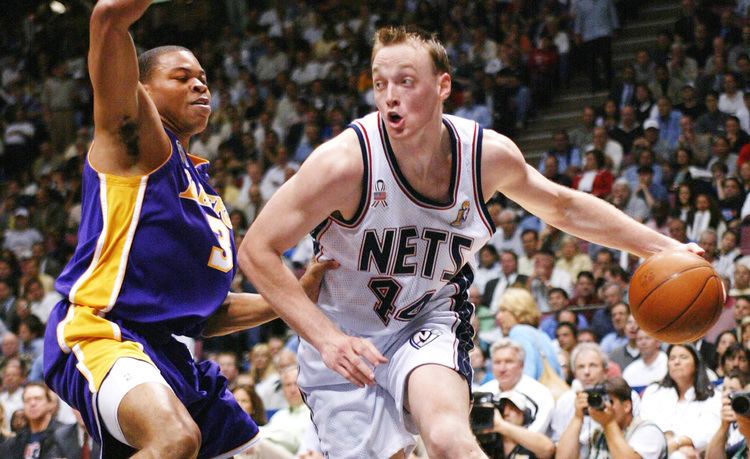Nationality American Pro career 1997–2006 Weight 111 kg Height 2.08 m | Listed weight 240 lb (109 kg) Role Basketball player Name Keith Horn | |
 | ||
NBA draft 1997 / Round: 1 / Pick: 2nd overall Spouse Amy Sida Van Horn (m. 1996) Similar People Kerry Kittles, Kenyon Martin, Larry Krystkowiak, Lionel Hollins, Rick Carlisle | ||
Listed height 6 ft 10 in (2.08 m) | ||
Nba 2k15 reggie theus vin baker keith van horn ultimate legends roster update 31
Keith Adam Van Horn (born October 23, 1975) is an American retired professional basketball player. The 6 ft 10 in (2.08 m), 240 pounds (110 kg) forward graduated from Diamond Bar High School in Diamond Bar, California and attended the University of Utah where he went on to be a consensus First Team All-American in 1997. Van Horn finished his career at Utah as the school and Western Athletic Conference (WAC) male all-time leading scorer (Colorado State's Becky Hammon is the all-time WAC leader with 2,740 points) and holds numerous other school records. He led Utah to three NCAA Division I top 25 finishes, including their highest ranking ever in school history (#2). He received the 1997 ESPN Men's College Basketball Performer of the Year award.
Contents
- Nba 2k15 reggie theus vin baker keith van horn ultimate legends roster update 31
- Njn keith van horn mix by misiek
- College career
- Professional career
- New Jersey Nets
- Philadelphia 76ers
- New York Knicks and Milwaukee Bucks
- Dallas Mavericks
- Free Agency and Retirement
- Personal life
- Achievements
- References
Van Horn was selected with the second pick of the 1997 NBA draft by the Philadelphia 76ers and was traded to the New Jersey Nets on a draft night trade. Van Horn played for the Nets from 1997 to 2002, leading the Nets in scoring in the 1997–98 and 1998–99 seasons where he averaged over 20 points per game and ranked fifth in the NBA in scoring in the 1999 season. He was a major contributor to the 2001–02 Nets team, leading the team in rebounding and placing second on the team in scoring. During his NBA career, Van Horn also played for the Philadelphia 76ers, New York Knicks, Milwaukee Bucks and Dallas Mavericks.

Van Horn officially retired from the NBA in 2008 and averaged 16.0 points and nearly 7 rebounds per game during his nine-year NBA career.

Njn keith van horn mix by misiek
College career

Van Horn was a highly recruited forward out of Diamond Bar High School in California. Rick Majerus recruited him to the University of Utah Utes to replace departing star Josh Grant. He played for Utah from 1993 to 1997 and received numerous All American awards during his career at Utah. In Van Horn's first season, he averaged a Utah-freshman record 18.3 points on 51 percent shooting and 8.3 rebounds per game even though his father died during the freshman year. As a sophomore, Van Horn led his team to the NCAA Tournament.
He is well known for his last second heroics, making back to back game winning shots against SMU and New Mexico in the 1997 WAC Conference Tournament. In 1997, he shot 90.4 percent from the free throw line and averaged 22.0 points and 9.5 rebounds per game to lead the Utes to a 29–4 finish and #2 national ranking, the highest in school history. This led to advancing to the NCAA Tournament's Elite Eight. As a senior, he was a consensus first team All American selection as a senior and was named ESPN Men's College Player of the Year in 1997.
Among his collegiate accomplishments is being the first player in WAC history to be named Player of the Year three times (1995,1996,1997), being the second player in WAC history to make first team all-WAC four years in a row and being the all-time leading scorer in University of Utah and WAC history with 2,542 points. Van Horn is the University of Utah career leader in points, defensive rebounds, three point field goals made, free throw percentage and is second in total rebounds. He averaged 20.8 points and 8.8 rebounds in his collegiate career. His #44 basketball jersey was retired by the University of Utah in 1998. In February 2008, he was among 16 players named to the University of Utah's "All-Century" basketball team. Van Horn was inducted to Utah's Crimson Club Hall of Fame in 2012.
Professional career
Van Horn was drafted as the second overall pick in the 1997 NBA draft by the Philadelphia 76ers; however, his rights were immediately traded to the New Jersey Nets along with Michael Cage, Lucious Harris and Don MacLean in exchange for the draft rights to Tim Thomas and Anthony Parker and player contracts of Jim Jackson and Eric Montross.
New Jersey Nets
Van Horn played for the Nets from 1997 to 2002. He was named 1st Team All Rookie in his first NBA season, averaging a team leading 19.7 points and 6.5 rebounds and leading the Nets to the NBA Playoffs, (the team's first in four years) where they were swept in three games by the Chicago Bulls. His best season as a pro came in 1999, where he averaged a team-leading 21.8 points per game (5th in the NBA) as well as 8.5 rebounds per game. He was an important part of the 2002 Nets team that won the Eastern Conference Championship, leading the team in rebounding and placing second in scoring, but was eventually swept by the Los Angeles Lakers in the 2002 NBA Finals. He hit the game-winning three point shot against the Boston Celtics in game 6 of the 2002 Eastern Conference Championships to send the Nets to the NBA finals. He ranks in the Nets top ten in several statistical categories including points, field goals made, three point field goals made and attempted, and offensive and defensive rebounds.
Philadelphia 76ers
On August 6, 2002 Van Horn was traded to his original team, the Philadelphia 76ers along with Todd MacCulloch for center Dikembe Mutombo. He spent one year with the 76ers placing second on the team in scoring and rebounding while the Sixers made the second round of the NBA playoffs.
New York Knicks and Milwaukee Bucks
After spending the year with the 76ers he was traded to the New York Knicks in a four team deal that also included the Atlanta Hawks and Minnesota Timberwolves. His stint with the Knicks, although productive, was short; on February 16, 2004 he was traded to the Milwaukee Bucks in a three team trade for Tim Thomas.
Dallas Mavericks
In order to make salary cap room for the signing of free-agent-to-be Michael Redd in the coming off season, on February 24, 2005 the Bucks traded Van Horn to the Dallas Mavericks for the expiring contracts of Alan Henderson, Calvin Booth and cash. He spent nearly two seasons with Dallas playing a key sixth man role and helping the Mavericks win the 2006 Western Conference Championship where they eventually lost in the NBA Finals to the Miami Heat.
Free Agency and Retirement
Following the 2006 NBA season, he took a year off in order to spend time with his family. On February 19, 2008 Van Horn signed a three-year deal (only the first year guaranteed) with the Mavericks in order to help complete a blockbuster trade that sent Jason Kidd from the New Jersey Nets to the Mavericks and Devin Harris to the Nets. As expected, Van Horn did not play at all for the Nets and was waived on October 23, 2008 and earned $4.3 million without playing.
Van Horn finished his NBA career with averages of 16.0 points per game and nearly 7 rebounds per game.
Personal life
Van Horn's and the Nets' success in his rookie year led him to be the first white player on the cover of SLAM Magazine. He was also on the cover of the NBA Jam 99 video game for both the Nintendo 64 and Game Boy Color.
Van Horn lived in Franklin Lakes, New Jersey during his time with the New Jersey Nets. Keith Van Horn lives in Bow Mar, Colorado, with his wife, Amy, and four children. Van Horn's eldest daughter Sabrina was born near the end of his sophomore year at Utah, followed by his son Nick and two other daughters Noelle and Haley. Sabrina played soccer for Mullen High School in Denver. Van Horn helped coach the basketball teams of his two other daughters. Having counseled Van Horn through the death of his father during his freshman season, Rick Majerus became close to Van Horn and was the godfather of Noelle.
Van Horn was a sociology major. He co-founded, after buying some on-the-river Colorado land, the Lincoln Hills Fly Fishing Club but later sold his majority interest in the club. Van Horn maintains a near 40-minute commute to his office in Littleton, Colorado, located west of Denver. He has a real estate investment firm; a school for kids with special needs; a mobile software company called Accuworks that created another mobile software company called Branded Business Apps.
Van Horn has an MBA and counts University of Utah benefactor Jon Huntsman Sr as a friend. He also runs the Colorado Premier Basketball Club, a non-profit youth basketball program involving around 1,000 kids from the Denver area. The club, claimed to be Colorado's largest basketball club, provides leagues, coaching, camps and tournaments for around 1,000 kids from the Denver area.
Achievements
College:
Professional:
